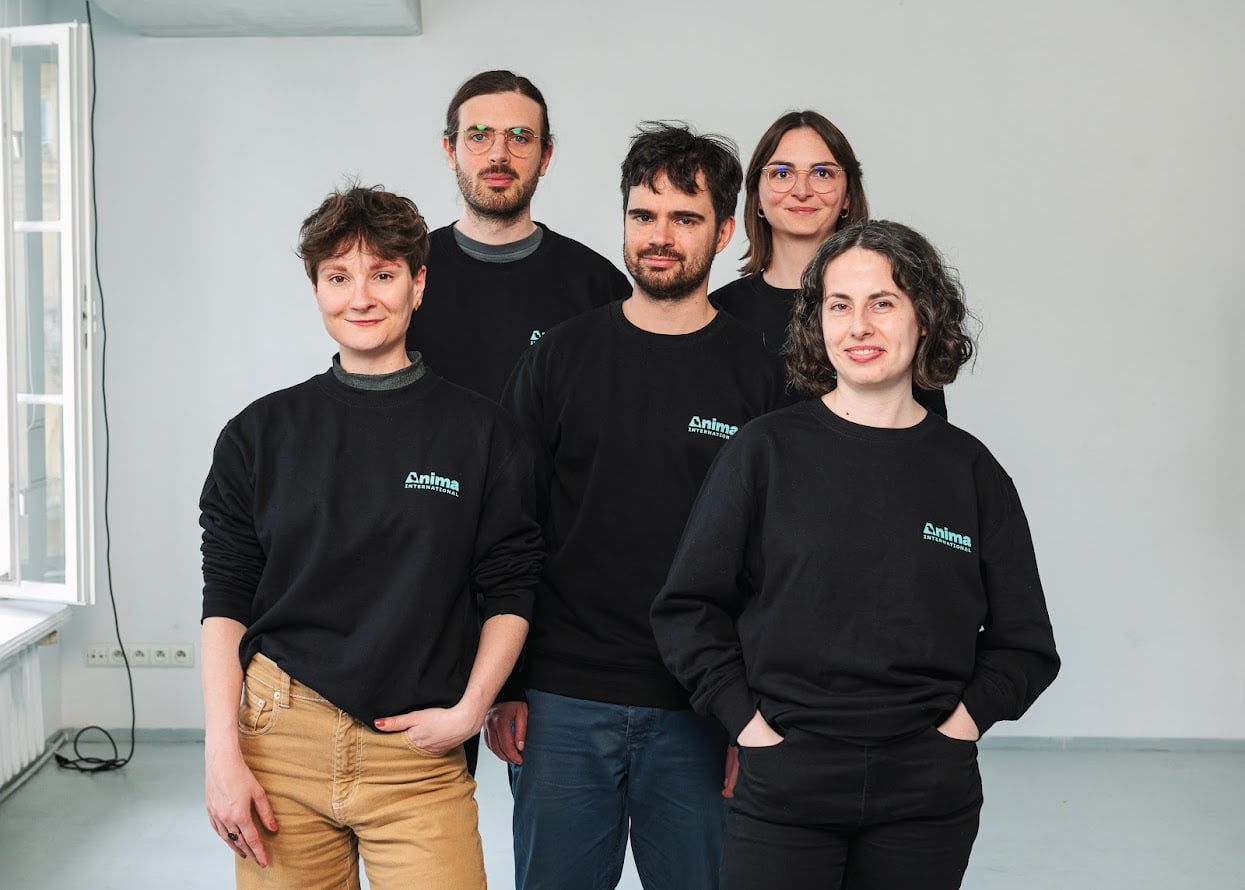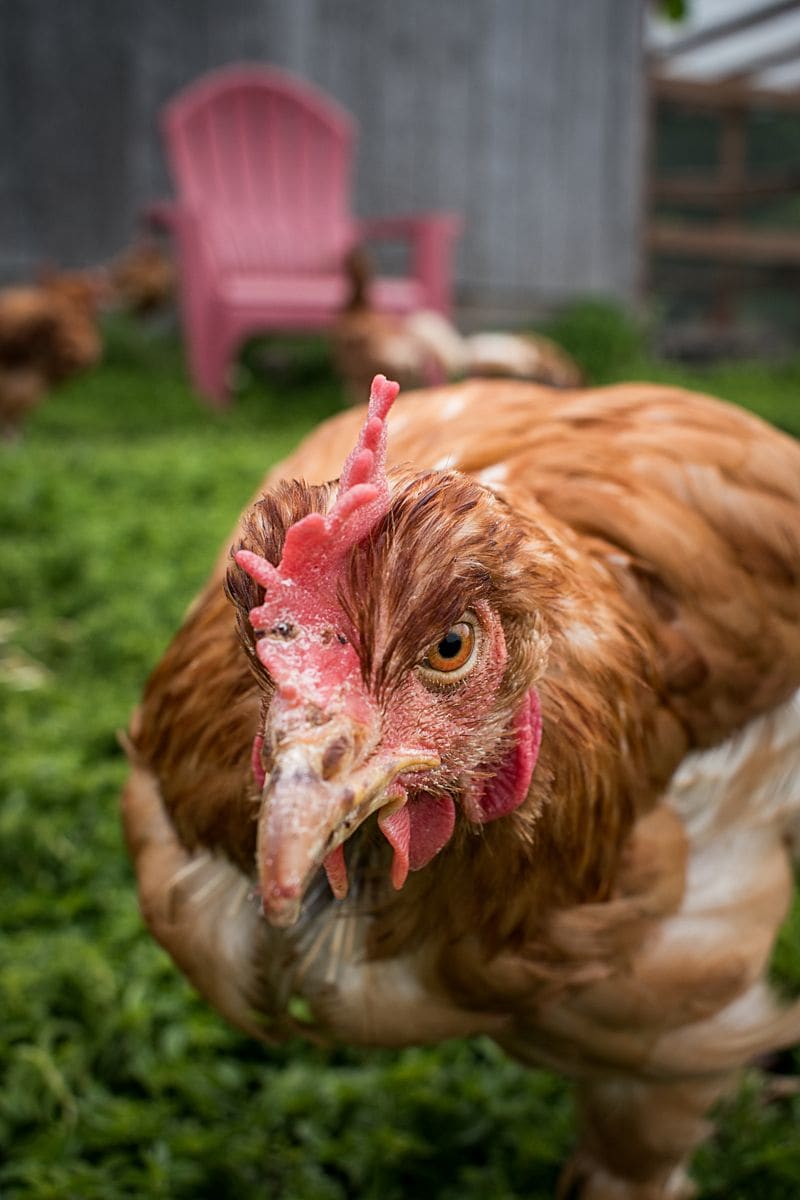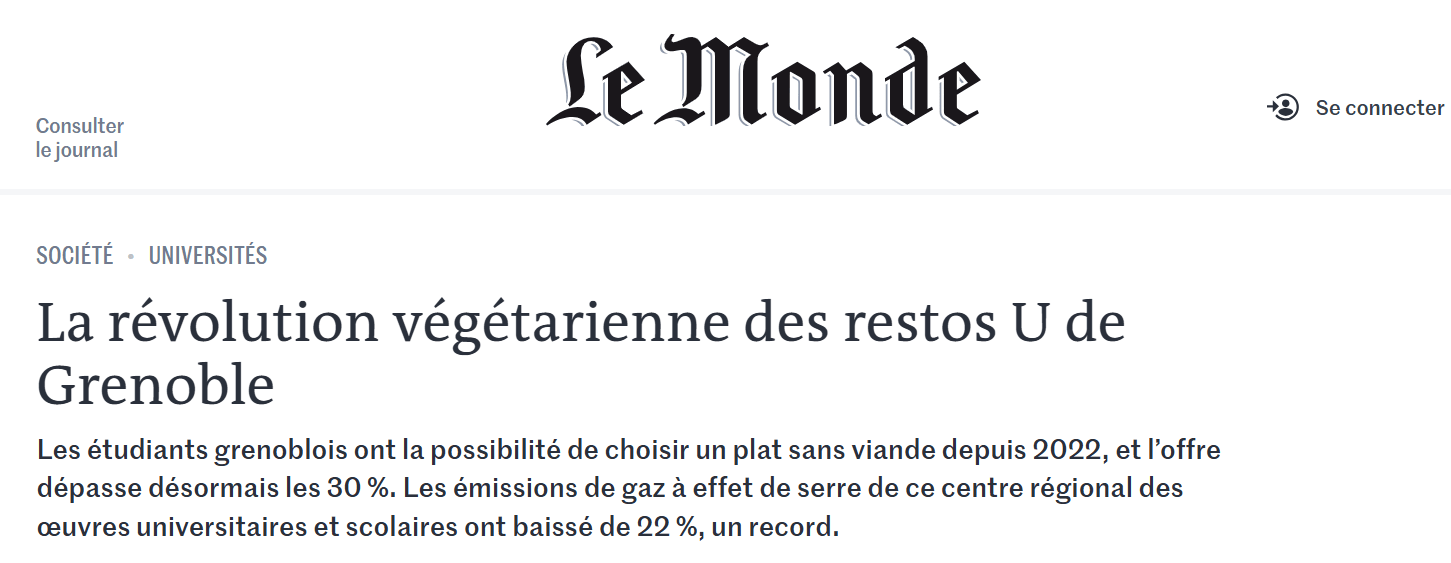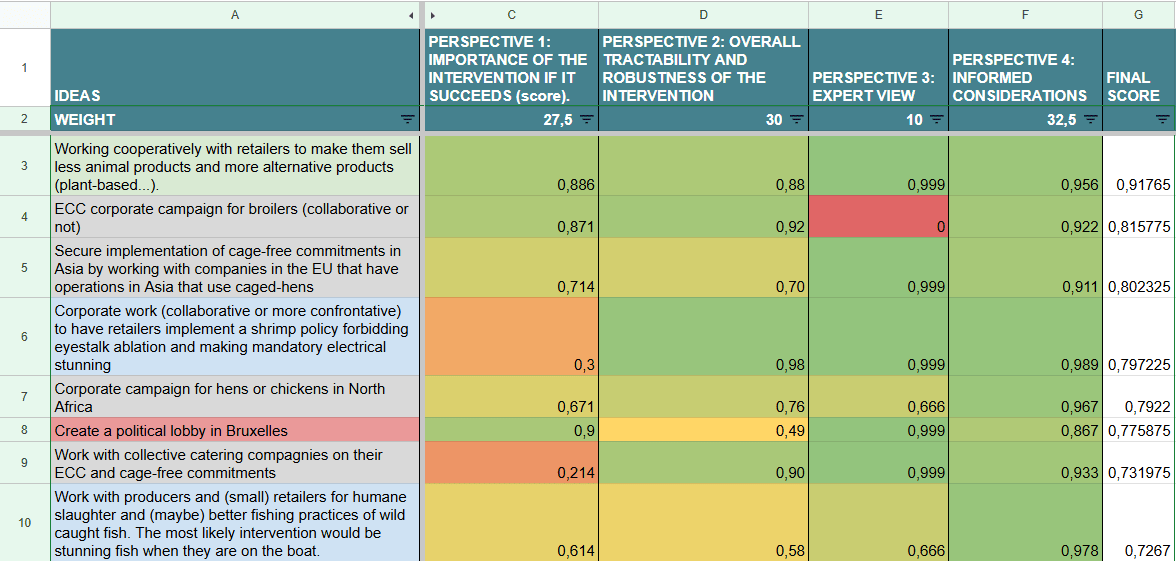My name is Keyvan, and I lead Anima International’s work in France. Our organization went through a major transformation in 2024. I want to share that journey with you.
Anima International in France used to be known as Assiettes Végétales (‘Plant-Based Plates’). We focused entirely on introducing and promoting vegetarian and plant-based meals in collective catering. Today, as Anima, our mission is to put an end to the use of cages for laying hens.
These changes come after a thorough evaluation of our previous campaign, assessing 94 potential new interventions, making several difficult choices, and navigating emotional struggles. We hope that by sharing our experience, we can help others who find themselves in similar situations. So let me walk you through how the past twelve months have unfolded for us.

Act One: What we did as Assiettes Végétales
Since 2018, we worked with the local authorities of cities, counties, regions, and universities across France to develop vegetarian meals in their collective catering services. If you don’t know much about France, this intervention may feel odd to you. But here, the collective catering sector feeds a huge number of people and produces an enormous quantity of meals. Two out of three children, more than seven million in total, eat at a school canteen at least once a week. Overall, more than three billion meals are served each year in collective catering. We knew that by influencing practices in this sector, we could reach a massive number of people.
However, this work was not easy. France has a strong culinary heritage deeply rooted in animal-based products. Meat and fish-based meals remain the standard in collective catering and school canteens. It is effectively mandatory to serve a dairy product every day in school canteens. To be a certified chef, you have to complete special training and until recently, such training didn’t include a single vegetarian dish among the essential recipes to master.
Despite the challenges, I believe we achieved significant success. Our most notable accomplishment was the change we were able to make with our university canteens campaign. Over a few years, we built strong partnerships with dozens of university restaurants nationwide (our debates with French chefs about whether a plant-based bourguignon can still be called bourguignon could probably fill a hundred-page thesis).
And this led to great results. Back in 2018, vegetarian meals were just starting to appear in university canteens. Now, all French university restaurants have committed to making 30% and 50% of the 35 million meals they serve vegetarian by 2025 and 2030, respectively. They are already reaching around 25% throughout the country.
Le Monde—the most widely read French newspaper—recently covered the “Vegetarian Revolution” taking place in the university restaurants in the city of Grenoble.
Of course, it is difficult to assess the exact part our work has played in these advancements, but we believe it is significant and has contributed to transforming French university catering, and thereby, what hundreds of thousands of young people eat every day[1].
So, why did we decide to stop most of this work?
Act Two: The moment we realized we needed to measure our impact more precisely
It seemed that our work was paying off and that we were on the right track for the animals. We regularly took a critical look at our strategy and improved it over time. However, there was one fundamental crux during our discussions that we hadn’t identified: the assumption that vegetarian meals inherently caused significantly less suffering than meat-based ones.
One day, we came across an article by Brian Tomasik, How Much Direct Suffering Is Caused by Various Animal Foods. In it, he tried to estimate the amount of suffering required to produce different types of animal products. One finding stood out: eggs had one of the highest suffering footprints—much higher than pork, for example. This was shocking to us, because many of the vegetarian meals our work helped introduce contained eggs[2]. It was a clear sign that we needed to assess our impact with even greater precision than before.
In our situation, taking animal suffering seriously meant taking the time to step back and carefully evaluate what our work was truly achieving for them. Ignoring the warning sign from Brian’s article would, in a way, have meant failing the very animals we were trying to help.
Act Three: The evaluation
From here, we proceeded systematically.
First, we collected 1,200 (!) menus from French canteens to understand exactly what the vegetarian and non-vegetarian dishes are made of in collective catering. We looked at:
- The proportion of beef, pork, salmon, chicken, etc. in non-vegetarian dishes
- The proportion of eggs, cheese, and plant-based proteins in the vegetarian options
- How it looks in schools vs. universities
Here’s what a typical weekly school menu looks like in France
(By the way, thanks to my mother for helping me go through these and sacrificing her eyesight for the animals.)
This. 1,200 times. Thanks mom.
Next, for each type of meal (pork, chicken, egg, plant-based, etc.), we estimated the suffering caused to animals for their production, using data from Faunalytics (on the duration of suffering per type of dish) and the Welfare Footprint Project (on the intensity of suffering).
Finally, we combined these two data sets to estimate how much suffering was avoided when a vegetarian meal replaced a non-vegetarian one.
The conclusion was very counter-intuitive. In university restaurants, vegetarian dishes cause significantly less suffering than non-vegetarian ones. This is because they use a relatively small number of eggs, all from free-range hens. But this is not the case for other types of collective catering. For example, school canteens use a lot of eggs when they serve vegetarian meals, and those eggs often come from caged hens. As I mentioned earlier, egg-based dishes are among the worst ones in terms of animal suffering. Overall, although our work did not cause additional animal suffering, the estimated short-term impact on reducing it was much lower than we originally thought[3].
Act Four: Ending our previous campaign
So, what to do? The immediate reduction of animal suffering through our actions was significantly lower than we had anticipated, the long-term effects on eating behavior were uncertain, and making progress after our initial victories in university catering had become increasingly challenging.
At the same time, we had achieved meaningful results, and our overall strategy still made sense. On top of that, when you've invested several years of your life into a campaign (for example, over six years for the co-founder of the organization, Cyril Ernst), built your organization's identity around it, and invested in specific tools, projects, and skills, making a 90-degree turn is not easy.
But our attachment to a strategy or past efforts should not hold us back from doing what’s best for the animals. We shouldn’t let our egos, routines, or past successes prevent us from choosing the most effective path forward. We have to strive to overcome our human limitations to act in the best interest of the billions of animals suffering right now.
It’s also worth noting that just because a strategy is good, it doesn’t mean it’s the best possible one for the animals. In fact, the strategy we follow at any given moment is unlikely to be the optimal one. There are countless ways to help animals, and the most effective ones are likely several times more impactful than the average approach. Of course, at some point, we need to commit to a path in order to see results. But given the estimates we had made, we strongly suspected that other interventions than our current one could be far more effective.
That’s why, in early 2024, we made the difficult decision to shift our campaign.
Act Five: Searching for a new intervention
At this point, we already had some ideas for interventions that could be highly effective in helping animals. But we didn't want to repeat the mistake we made back in 2018 (hard to avoid with our knowledge and mindset at the time), of launching a campaign without seriously investigating its potential impact on animals.
So, we launched a six-month research process based on the methodology from Ambitious Impact (formerly Charity Entrepreneurship), with support from Animal Ask, whose tools helped guide our work.
The first step was to generate a large number of intervention ideas, without limiting ourselves to ‘obvious’ or ‘easy’ ones. We talked with dozens of experts and activists, read research reports, and tried to think on our own about what could be done to help animals. At this stage, we came up with a total of 94 ideas.
Next, we did a quick evaluation of all these ideas to narrow them down to nine:
- Working with retailers to make them sell fewer animal products and more plant-based alternatives
- Ensuring the implementation of cage-free commitments in Asia by working with EU companies that have operations in Asia using caged hens
- Running corporate or advocacy cage-free campaigns for hens in North Africa
- Implementing fish stunning on boats in France
- Improving the welfare of farmed fish in France
- Making companies in France implement the ECC (European Chicken Commitment)
- Ending the use of cages for laying hens in France
- Convincing French companies to implement mandatory electrical stunning for shrimps
- Preventing the adoption of the worst practices (like cages and fast-growing breeds) in factory farming in Africa
Excerpt from the table where we quickly evaluated our first 94 ideas. All this research helped us greatly improve our Google Sheets skills.
Finally, we wrote a detailed report on each of the nine selected interventions, each requiring a dozen hours. The only thing left to do was to choose our next campaign.
Act Six: The struggle to choose
At Anima International, we approach our work with a deep sense of ownership. In this case, it meant I could turn to my colleagues for all the input and feedback I needed to make my decision, but ultimately it was up to me to make the final call on our future and I would be the person accountable for it. It’s highly freeing to work with such autonomy, but it also comes with a great responsibility. Having to make such a consequential choice can paralyze a person. And indeed, this is what happened to me.
For the first time in my life, I viscerally felt how the emotional and interpersonal considerations could cloud my judgment. What will my colleagues think of my decision? What about the other animal organizations in France? Am I biased toward some interventions, like plant-based work, because it’s similar to our previous campaign and thus psychologically more comfortable? Am I capable enough to make the right decisions for the animals who suffer so much?
Honestly, I was surprised how difficult it was for me to make a choice. I was emotionally drained, procrastinated on the decision for weeks, and changed my mind several times about what seemed best (leaning towards working on the European Chicken Commitment, or the plant-based work).
After all these months of research, I felt pressure for us to move on and start the new campaign. I started doubting whether I’m a good enough activist or whether my poor decision-making ability was hurting animals.
In the end, I decided we should work on ending cages for hens in France. I realized that I had been biased against this intervention because the cage-free campaign didn't seem ambitious and ‘cool’ enough. Part of me wanted ‘bigger things’ to happen than ‘just’ implementing cage-free commitments in a country like France with ‘only’ 27% of hens in cages.
Noticing this about myself helped me to overcome this bias. It doesn't matter whether an intervention seems ‘very ambitious[4]’. Of course, I would like to save all animals at once. It's disheartening to realize that you can't, and the best you can do for them for now is to ‘only’ free them from cages. But I cannot change the world by being angry about how fucked up it is. I have to be at peace with this kind of realization and do my best to pursue the interventions with the highest expected value.
After I made the call, I waited a bit to make sure I wasn’t going to change my mind again, but this time I felt firmly aligned with my decision. It was a huge relief. I felt I had been able to see through all the confusion and make the best (but not obvious to me at first) choice for the animals.
Act Seven: The strengths of the cage-free campaign
It was decided: our goal is to end the use of cages for laying hens. Working with French companies to ensure they honor their cage-free commitments will be one of our main tools for this mission. We will also focus on policy: the fewer hens there are in cages in France, the easier it will be to push for a full ban—both in France and across Europe, as the European Commission promised in response to the End the Cage Age citizens’ initiative.
I want to share what I think are the main strengths of this campaign. Things like this can be easily overlooked when we want to have a meaningful impact for animals right away:
- High Tractability: It’s likely no exaggeration to say that the international campaign to phase out cages for laying hens has achieved more real progress for animals than any other initiative. Lewis Bollard, Farm Animal Welfare Program Director at Open Philanthropy, estimates that 200 million hens are already cage-free at any given time thanks to these campaigns, with an additional 250 million if all commitments are met. Animal activists’ efforts on this issue are paying off. High tractability also means more victories and more positive dynamics, which are probably important for a social movement (more on this in this article from @JamesÖz ).
- Robust reduction in animal suffering: Estimates from the Welfare Footprint Project indicate a robustly positive and significant reduction in the suffering of hens when moving from cages to cage-free systems[5].
- Completing the work our movement started: A large number of companies have committed to phasing out cage eggs by 2025. While many are making the necessary progress, others are not keeping up. Ensuring that companies are held accountable for their commitments to animals is the crucial final step of the global cage-free campaign.
- A valuable training opportunity: Despite being a massive international organization that is very influential in other countries, in France our team is small and mostly trained to work on vegetarian meals in collective catering. This well-defined campaign (ensuring companies honor their cage-free commitments) with high chances of success increases the likelihood that we can have an impact quickly and allows us to develop skills for potentially more challenging campaigns in the future.
Conclusion – Where we stand today
In October 2024, we unveiled our new identity as Anima and launched our new website, along with our new campaign to end cages for laying hens.
We’ve already met with several major companies committed to going cage-free by 2025 to track their progress. We’re collecting data on the percentage of cage-free eggs used in the wholesale and collective catering sectors, which we identified and targeted as being the furthest behind in the transition away from cages. We plan to widely publicize this data—through the press and all the contacts we've built over the years in the collective catering sector—to ensure maximum transparency of the industry. We have also reached out to numerous Members of Parliament, which has led to several of them questioning the French government about the end of cages.
We made many mistakes along the way, but I believe Anima, formerly Assiettes Végétales, is on a better path to helping animals than it was a year ago. I am happy that we made this pivot in strategy and identity. With the limited information we had, I believe we made the most reasonable (and courageous) decisions. Now it’s up to us to explore this path and make a difference for animals.

***
If you’d like to support us (we’ve lost some of our funders due to this switch!), have any questions, or want to discuss impact evaluation, I’d be happy to chat: keyvan.mostafavi@animafrance.org
Acknowledgements:
Special thanks to organizations whose research and tools informed our work: Animal Ask, Faunalytics, Welfare Footprint Project and Ambitious Impact.
Thanks to @saulius for our discussions and for his support during the challenging process of choosing our next campaign.
Feedback and proofreading: @Jakub Stencel, @KirstyHenderson, Anna Bearne, @Ania Kozłowska
- ^
The universities we collaborated with are among the most advanced ones in terms of vegetarian meals, and were the precursors for all other universities to commit to 50% vegetarian meals. We also made vegetarian meals a hot topic among university canteens by talking with a lot of decision makers in the sector, training the cooks, and organising events promoting vegetarian meals with university canteens that were very visible. We also influenced the law regulating training standards.
- ^
We started our campaign by asking for plant-based meals only. But we quickly realized that making progress this way was very difficult—French culinary tradition is even less open to plant-based meals than to vegetarian ones. That’s why we took the strategic decision to focus our demands on vegetarian meals instead (even though the recipes and training we provided to chefs were still plant-based).
- ^
Increasing the number of vegetarian meals and exposing children to plant-based food likely has long-term effects on dietary habits. However, these effects are difficult to study and quantify, as there is no precise scientific research on this topic.
- ^
Of course, it’s worth underlining that working on cage-free work is indeed ambitious and very hard. It’s about pushing a significant part of the French and global economy to change how they produce their eggs. Impact totalling to over 12 million hens.
- ^
It should be noted that some people are concerned that the slightly higher prevalence of keel bone fractures in cage-free systems compared to furnished cages might negatively offset the benefits of this transition.




Very engaging post! I appreciated how it covered the many different aspects of the decision-making and transition process: rational, practical, social and emotional. I feel like this would have value to animal advocates who are not particularly interested in EA, as it would be a very concrete way of introducing the difficult questions one grapples with when considering impact. However, I am not sure where else this could be posted in order for members of this wider audience to access it.
I hope this is not too much of a digression from the core of the post, but I was struck to see that you cited Brian Tomasik's article as being more or less the spark that set the organization off on the course of reevaluating their interventions, and eventually changing their domain of action. I often notice individuals in EA organizations - or non-EA animal advocates - citing Tomasik as someone who has led them to reevaluate their considerations, and sometimes even to change the type of interventions that they put in place. He also seems to have come first in advocating for earning-to-give (in 2006), appears to be one of the most cited advocates for reducing wild-animal suffering (2009), created the second-ever table trying to evaluate direct suffering caused by animal foods (2007), and wrote the first article dedicated to s-risks (2013). These things have all been substantially expanded upon since, and some, such as Wild Animal Welfare, are even considered by somes as EA causes in their own right. Would I be wrong in considering Brian Tomasik's influence as having been comparably far-reaching within the movement (especially on the level of ideas) as Toby Ord's or Nick Bostrom's ?
(Side note: I know this is probably not the most important subject to think about, but I find it helpful to get a clearer picture of where the core concepts and claims that make up Effective Altruism come from, in order to be more aware of the contingencies of the movement; also, trying to vaguely keep track of this helps me reflect on the influence that sharing ideas can have - and that is something where on the surface level, Tomasik's record seems out of the ordinary, especially for someone who isn't much of a public figure).
Thanks for sharing this write-up! It's not easy to massively change direction in response to new evidence but it seems like you did a great job.
On the object level, for my interest: do you know why the egg density was so different between university and other catered meals?
I followed the whole process and still I am super impressed by the whole approach!
Very few orgs go through the process of looking at everything that can be done and choosing the best opportunity. Especially with suffering reduction as the main goal. I'd love it if more orgs were able to do that.
Excellent post.